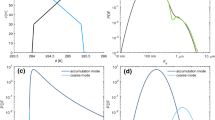Abstract
A one-dimensional model of radiation fog with detailed microphysics is presented. Aerosols and cloud droplets are treated in a joint two-dimensional size distribution. Radiative fluxes are calculated as functions of the radiative properties of the time-dependent particle spectra. The droplet growth equation is solved by considering radiative effects. Turbulence is treated by means of a higher order closure model. The interaction between the atmosphere and the earth's surface is explicitly simulated.
Three numerical sensitivity studies are performed to investigate the impact of the different physico-chemical properties of urban, rural and maritime aerosols on fog formation. Numerical results elucidate that depending on the aerosol type used, the resulting fog events are completely different. This is particularly true for the times of fog formation and dissipation as well as for the liquid water content and supersaturations within the fogs. In the activated part of the particle spectra, the aerosol mass is very inhomogeneously distributed. The maxima of the curves do not coincide with the maxima of the corresponding liquid water distributions.
Similar content being viewed by others
References
Arganza, Garcia, Fernandez Diaz, J. M., Garzon Ruiperez, L., and Lopez, A.: 1988, ‘Concentration Sources and Particle Size Distribution of the Atmospheric Aerosol of the Oviedo Urban Nucleus (Spain)’, Atmos. Envir. 22, 2863–2869.
Ayers, G. P. and Gras, J. L.: 1983, ‘The Concentration of Ammonia in Southern Ocean Air’, J. Geophys. Res. 88, 10,655–10,659.
Barkstrom, B. R.: 1978, ‘Some Effects of 8–12 Μm Radiant Energy Transfer on the Mass and Heat Budgets of Cloud Droplets’, J. Atmos. Sci. 35, 665–673.
Beard, K. V.: 1976, ‘Terminal Velocity and Shape of Cloud and Precipitation Drops Aloft’, J. Atmos. Sci. 33, 851–864.
Bott, A.: 1989a, ‘A Positive Definite Advection Scheme Obtained by Nonlinear Renormalization of the Advective Fluxes’, Mon. Wea. Rev. 117, 1006–1015.
Bott, A.: 1989b, ‘Reply’, Mon. Wea. Rev. 117, 2633–2636.
Bott, A., Sievers, U., and Zdunkowski, W.: 1990, ‘A Radiation Model with a Detailed Treatment of the Interaction Between Radiative Transfer and Fog Microphysics’, J. Atmos. Sci. 47, 2153–2166.
Clapp, R. and Hornberger, G.: 1978, ‘Empirical Relations for Some Soil Hydraulic Properties’, Water Resour. Res. 14, 601–604.
Clarke, R. H.: 1970, ‘Recommended Methods for the Treatment of the Boundary Layer in Numerical Models’, Austr. Meteorol. Mag. 18, 51–73.
Davies, R.: 1985, ‘Response of Cloud Supersaturation to Radiative Forcing’, J. Atmos. Sci. 42, 2820–2825.
Forkel, R., Sievers, U., and Zdunkowski, W.: 1987, ‘Fog Modelling with a New Treatment of the Chemical Equilibrium Condition’, Beitr. Phys. Atmos. 60, 340–360.
Gerber, H. E.: 1981, ‘Microstructure of Radiation Fog’, J. Atmos. Sci. 38, 454–458.
Hänel, G.: 1976, ‘The Properties of Atmospheric Aerosol Particles as Functions of Relative Humidity at Thermodynamic Equilibrium with the Surrounding Moist Air’, Adv. Geoph. 19, 73–188.
Hale, G. M. and Querry, M. R.: 1973, ‘Optical Constants of Water in the 200-nm to 200-Μm Wavelength Region’, Appl. Opt. 12, 555–563.
Hall, W. D.: 1980, ‘A Detailed Microphysical Model within a Two-Dimensional Dynamic Framework: Model Description and Preliminary Results’, J. Atmos. Sci. 37, 2486–2507.
Jaenicke, R.: 1988, ‘Aerosol Physics and Chemistry’, in Landolt-Boernstein Zahlenwerte und Funktionen aus Naturwissenschaften und Technik, Springer V 4b, 391–457.
Jiusto, J. E. and Lala, G. G.: 1983, ‘Radiation Fog Field Programs — Recent Studies’, ASRC-SUNY, Pub. No. 869.
McCumber, M. C. and Pielke, R. A.: 1981, ‘Simulation of the Effects of Surface Fluxes of Heat and Moisture in a Mesoscale Numerical Model’, J. Geophys. Res. 86, 9929–9938.
Mellor, G. L. and Yamada, T.: 1974, ‘A Hierarchy of Turbulence Closure Models for Planetary Boundary Layers’, J. Atmos. Sci. 31, 1791–1806.
Mellor, G. L. and Yamada, T.: 1982, ‘Development of a Turbulence Closure Model for Geophysical Fluid Problems’, Rev. Geoph. Space Phys. 20, 851–875.
Meszaros, A. and Vissy, K.: 1974, ‘Concentration, Size Distribution and Chemical Nature of Atmospheric Aerosol Particles in Remote Ocean Areas’, J. Aerosol Sci. 5, 101–109.
Parungo, F. P., Nagamoto, C. T., Madel, R., Rosinski, J., and Haagenson, P. L.: 1987, ‘Marine Aerosols in Pacific Upswelling Regions’, J. Aerosol Sci. 18, 277–290.
Parungo, F. P., Nagamoto, C. T., Rosinski, J., and Haagenson, P. L.: 1986, ‘A Study of Marine Aerosols over the Pacific Ocean’, J. Atmos. Chem. 4, 199–226.
Pielke, R. A.: 1984, Mesoscale Meteorological Modeling, Academic Press, Orlando, 612 pp.
Pruppacher, H. R. and Klett, J. D.: 1980, Microphysics of Clouds and Precipitation, D. Reidel Publishing Company, Dordrecht, Holland, 714 pp.
Pueschel, R. F., Boatman, J. F., and Artz, R. S.: 1988, ‘Aerosols over the Western Atlantic: Scale Heights, Concentrations and Fluxes’, Atmos. Environ. 22, 2371–2380.
Roach, W. T.: 1976a, ‘On Some Quasi-Periodic Oscillations Observed During a Field Investigation of Radiation Fog’, Quart. J. Roy. Meteorol. Soc. 102, 355–359.
Roach, W. T.: 1976b, ‘On the Effect of Radiative Exchange on the Growth by Condensation of a Cloud or Fog Droplet’, Quart. J. Roy. Meteorol. Soc. 102, 361–372.
Roache, P. J.: 1982, Computational Fluid Dynamics, Hermosa Publishers, Albuquerque, 446 pp.
Shettle, E. P. and Fenn, R. W.: 1979, ‘Models for the Aerosols of the Lower Atmosphere and the Effects of Humidity Variations on their Optical Properties’, Project 7670, Air Force Geoph. Lab., Massachusetts.
Warneck, P.: 1988, Chemistry of the Natural Atmosphere, International Geophysics Series, 41, Academic Press, New York, 753 pp.
Winkler, P.: 1974, ‘Die relative Zusammensetzung des Atmosphärischen Aerosols in Stoffgruppen’, Meteorol. Rdsch. 27, 129–136.
Woodcock, A. H.: 1978, ‘Marine Fog Droplets in Salt Nuclei-Part I’, J. Atmos. Sci. 35, 241–268.
Zdunkowski, W. G., Panhans, W.-G., Welch, R. M., and Korb, G. J.: 1982, ‘A Radiation Scheme for Circulation and Climate Models’, Beitr. Phys. Atmos. 55, 215–238.
Author information
Authors and Affiliations
Rights and permissions
About this article
Cite this article
Bott, A. On the influence of the physico-chemical properties of aerosols on the life cycle of radiation fogs. Boundary-Layer Meteorol 56, 1–31 (1991). https://doi.org/10.1007/BF00119960
Received:
Issue Date:
DOI: https://doi.org/10.1007/BF00119960




